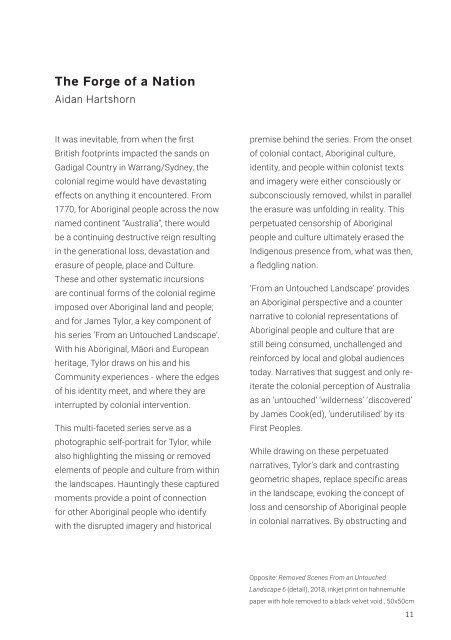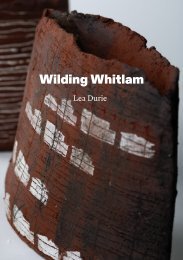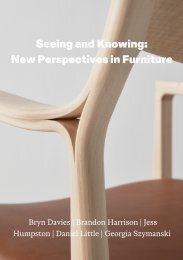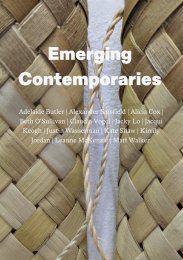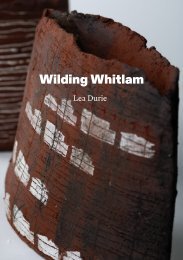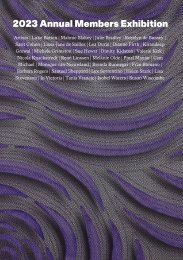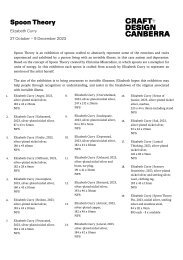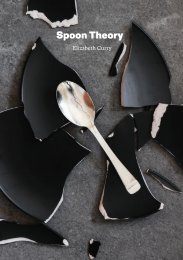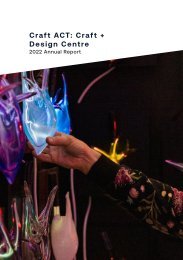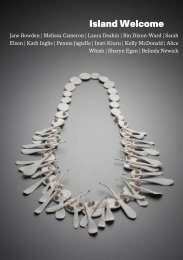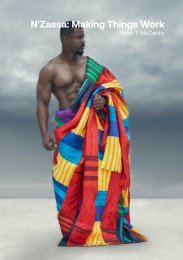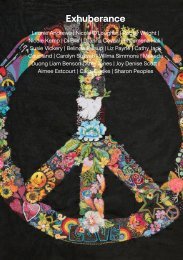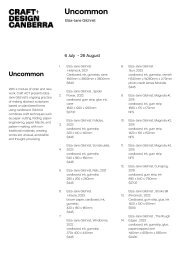From an untouched landscape exhibition
Artist James Tylor highlights the contemporary absence of Aboriginal culture within the Australian landscape and how this phenomenon is a direct result of the impact of European colonisation in From An Untouched Landscape. As Tylor explains, the first European colonists forced the local Aboriginal people off their traditional lands and into small Christian missions and government reserves. This allowed the new European arrivals free access to clear the land for settlements, forestry and agriculture. This clearing of Aboriginal people from the landscape resulted in the removal of Indigenous cultural artifacts and identity from the Australian landscape.
Artist James Tylor highlights the contemporary absence of Aboriginal culture within the Australian landscape and how this phenomenon is a direct result of the impact of European colonisation in From An Untouched Landscape.
As Tylor explains, the first European colonists forced the local Aboriginal people off their traditional lands and into small Christian missions and government reserves. This allowed the new European arrivals free access to clear the land for settlements, forestry and agriculture. This clearing of Aboriginal people from the landscape resulted in the removal of Indigenous cultural artifacts and identity from the Australian landscape.
You also want an ePaper? Increase the reach of your titles
YUMPU automatically turns print PDFs into web optimized ePapers that Google loves.
The Forge of a Nation<br />
Aid<strong>an</strong> Hartshorn<br />
It was inevitable, from when the first<br />
British footprints impacted the s<strong>an</strong>ds on<br />
Gadigal Country in Warr<strong>an</strong>g/Sydney, the<br />
colonial regime would have devastating<br />
effects on <strong>an</strong>ything it encountered. <strong>From</strong><br />
1770, for Aboriginal people across the now<br />
named continent “Australia”, there would<br />
be a continuing destructive reign resulting<br />
in the generational loss, devastation <strong>an</strong>d<br />
erasure of people, place <strong>an</strong>d Culture.<br />
These <strong>an</strong>d other systematic incursions<br />
are continual forms of the colonial regime<br />
imposed over Aboriginal l<strong>an</strong>d <strong>an</strong>d people;<br />
<strong>an</strong>d for James Tylor, a key component of<br />
his series ‘<strong>From</strong> <strong>an</strong> Untouched L<strong>an</strong>dscape’.<br />
With his Aboriginal, Māori <strong>an</strong>d Europe<strong>an</strong><br />
heritage, Tylor draws on his <strong>an</strong>d his<br />
Community experiences - where the edges<br />
of his identity meet, <strong>an</strong>d where they are<br />
interrupted by colonial intervention.<br />
This multi-faceted series serve as a<br />
photographic self-portrait for Tylor, while<br />
also highlighting the missing or removed<br />
elements of people <strong>an</strong>d culture from within<br />
the l<strong>an</strong>dscapes. Hauntingly these captured<br />
moments provide a point of connection<br />
for other Aboriginal people who identify<br />
with the disrupted imagery <strong>an</strong>d historical<br />
premise behind the series. <strong>From</strong> the onset<br />
of colonial contact, Aboriginal culture,<br />
identity, <strong>an</strong>d people within colonist texts<br />
<strong>an</strong>d imagery were either consciously or<br />
subconsciously removed, whilst in parallel<br />
the erasure was unfolding in reality. This<br />
perpetuated censorship of Aboriginal<br />
people <strong>an</strong>d culture ultimately erased the<br />
Indigenous presence from, what was then,<br />
a fledgling nation.<br />
‘<strong>From</strong> <strong>an</strong> Untouched L<strong>an</strong>dscape’ provides<br />
<strong>an</strong> Aboriginal perspective <strong>an</strong>d a counter<br />
narrative to colonial representations of<br />
Aboriginal people <strong>an</strong>d culture that are<br />
still being consumed, unchallenged <strong>an</strong>d<br />
reinforced by local <strong>an</strong>d global audiences<br />
today. Narratives that suggest <strong>an</strong>d only reiterate<br />
the colonial perception of Australia<br />
as <strong>an</strong> ‘<strong>untouched</strong>’ ‘wilderness’ ‘discovered’<br />
by James Cook(ed), ‘underutilised’ by its<br />
First Peoples.<br />
While drawing on these perpetuated<br />
narratives, Tylor’s dark <strong>an</strong>d contrasting<br />
geometric shapes, replace specific areas<br />
in the l<strong>an</strong>dscape, evoking the concept of<br />
loss <strong>an</strong>d censorship of Aboriginal people<br />
in colonial narratives. By obstructing <strong>an</strong>d<br />
Opposite: Removed Scenes <strong>From</strong> <strong>an</strong> Untouched<br />
L<strong>an</strong>dscape 6 (detail), 2018, inkjet print on hahnemuhle<br />
paper with hole removed to a black velvet void , 50x50cm<br />
11


